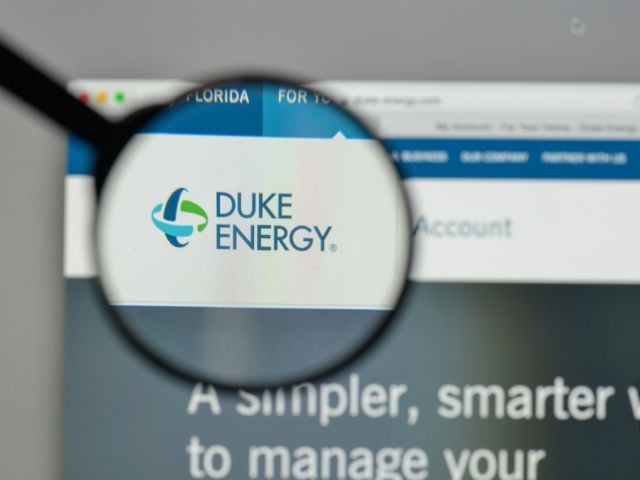Summary
Mr. Chairman, distinguished Members of the Committee: My name is Dusty Horwitt, and I am a Public Lands Analyst at Environmental Working Group (EWG), a nonprofit research and advocacy organization based in Washington, DC, and Oakland, California. I thank the members of the Committee for this opportunity to testify.
For the last several years, the Environmental Working Group has analyzed mining claims on federal land, using computerized data provided by the Bureau of Land Management.
Mr. Chairman, what we have found is a frenzy of claim staking that is escalating each day and threatens a crisis for many of America’s most treasured wild places and national parks, including the Grand Canyon, where there has been an explosion of uranium mining claims. This modern-day land rush is driven by the sky-high price of uranium, gold and other metals caused by demand from China, the United States and players around the globe.
Since 2003, claims on all public land in 12 Western states have increased by 80 percent. This dramatic surge in claims could be extremely problematic because once a claim is staked, the federal government interprets mining law as providing virtually no way to stop hard rock mining at that site, short of buying out mining claims or other congressional intervention, even when mining is in plain view of national parks such as the Grand Canyon.
As you well know, a valid mining claim gives the claim holder the opportunity to mine on federal land and can be staked without government approval or oversight wherever land is open to mining. This Wild West approach stands in stark contrast to the approval required through the oil and gas leasing program where the public has an opportunity to participate in decisions that affect public lands. As anyone knows who has been in the West in the past five years, this approval process has not in any way stymied oil and gas exploration.
More than four years of analysis of mining claims has led us to one inescapable conclusion: Under the current, wide open mining law, vast portions of the American West are at the mercy of global demand for minerals. This is simply unacceptable. Without changes to the law, global demand for minerals could easily result in situations where companies begin prospecting and developing mining claims right next to incomparable wonders like the Grand Canyon, other national parks and wilderness areas, or even local water supplies.
Globalization has finally caught up with the 1872 Mining Act and rendered it totally and definitively obsolete. The West is not as big as it used to be. With growing demand for metals we do not need a Mining Law designed to encourage mining; we need a mining law that both permits mining, but also protects, without wavering, our most important natural places and resources.
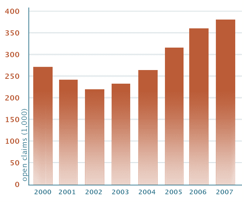
Source: Environmental Working Group analysis of
Bureau of Land Management's LR2000 Database, July 2007 download.
Active Mining Claims Increased More than 80% since January 2003
Our research shows that in 12 Western states, the number of active mining claims has increased from 207,540 in January 2003 to 376,493 in July 2007, a rise of more than 80 percent. Over an eight-month period, from last September to this May, the BLM recorded more than 50,000 new mining claims. Claims as of July 2007 covered an estimated 9.3 million acres.
We have seen this increase in every Western state, with claims for all metals increasing by 50 percent or more in Arizona, Colorado, New Mexico, Nevada, South Dakota, Utah and Wyoming.
Mining claims have increased in every one of twelve Western states.
| State | Claims active as of January 2003 | Claims active as of July 2007 | Percent Increase |
| Arizona | 22,711 | 40,670 | 79% |
| California | 18,981 | 22,494 | 19% |
| Colorado | 5,430 | 18,391 | 239% |
| Idaho | 10,598 | 13,013 | 23% |
| Montana | 10,554 | 12,779 | 21% |
| New Mexico | 7,550 | 11,348 | 50% |
| Nevada | 100,972 | 179,773 | 78% |
| Oregon | 5,088 | 6,087 | 20% |
| South Dakota | 1,030 | 2,340 | 127% |
| Utah | 8,723 | 28,968 | 232% |
| Washington | 2,193 | 2,492 | 14% |
| Wyoming | 13,710 | 38,138 | 178% |
| 12 state total | 207,540 | 376,493 | 81% |
Source: Environmental Working Group analysis of Bureau of Land Management's LR2000 Database, July 2007 download.
Attached to the end of this statement are maps of several Western states that show the locations of active claims.
Many of the new claims are for uranium. The BLM reports that the estimated number of uranium claims staked in Colorado, New Mexico, Utah and Wyoming combined increased approximately 750 percent from less than 4,300 in fiscal year 2004 to more than 32,000 in fiscal year 2006.
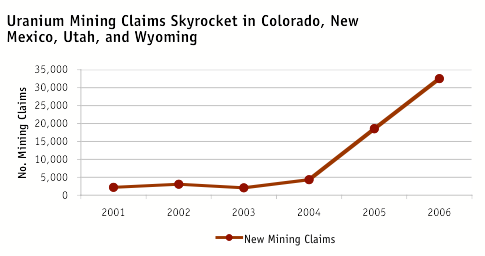
Source: Bureau of Land Management
Many of the claims for all metals are being staked by foreign mining companies and speculators who could mine the land or sell to multinational corporations. Mining companies often extract minerals using techniques involving toxic chemicals, giant earthmoving equipment, sprawling road networks and vast quantities of water where water is a precious, scarce resource.
This land rush is sweeping the West despite the remnants of an earlier generation of uranium mines that have left a legacy of death and disease, despite the fact that mining as a whole is our leading source of toxic pollution and despite the fact that mining claims give companies a right to mine that effectively supercedes efforts to protect the environment and preserve our American heritage.
In the face of a landslide of global economic forces that threaten many of our most valued natural places and the health of people all across the American West, the 1872 Mining Law offers the legal equivalent of a pick and a shovel.
The following photo images were produced by EWG by linking federal data on mining claims with Google Earth satellite photos of national parks. They show the clear threats to some of our most treasured national parks and depict areas that bear the legacy of past uranium mining pollution.
815 Mining Claims within 5 Miles of Grand Canyon National Park, 805 Staked Since January 2003
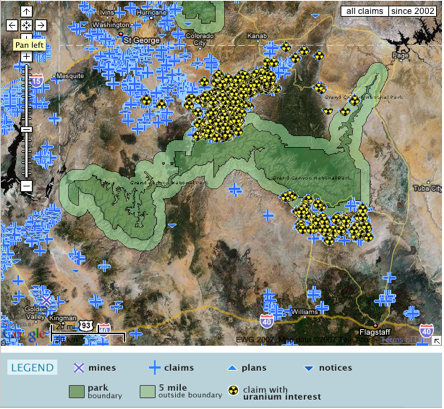
Source: Environmental Working Group analysis of Bureau of Land Management's LR2000 Database, July 2007 download.
This satellite image of Grand Canyon National Park shows mining claims featured in blue and uranium claims identified with the yellow and black radiation symbol, clustered on both the north and south rims. We found that as of July, mining interests held 815 claims within five miles of the Park, 805 of them staked since January 2003. Many of these claims are for uranium.
A Canadian company, Quaterra Resources, has already proposed to drill exploratory holes for uranium on claims just north of the Canyon. The operation would include a helicopter pad to carry supplies in and out. The idea of uranium mining near America’s greatest national treasure is troubling and the thought of helicopter flights of radioactive material in an area already crisscrossed by dozens of tourist flyovers a day is even more disconcerting.
The same explosion of claims has occurred in the canyon country of southern Utah and Colorado.
869 Mining Claims within 5 Miles of Arches National Park, 864 Staked Since January 2003;
233 Mining Claims within 5 Miles of Canyonlands National Park, All Staked Since January 2003
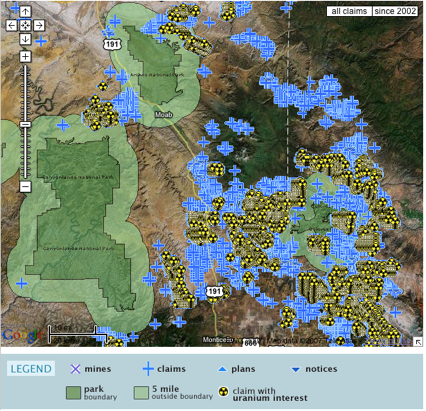
Source: Environmental Working Group analysis of Bureau of Land Management's LR2000 Database, July 2007 download. Uranium claims and companies/individuals with uranium interests were identified through BLM records and other public documents.
Many of these claims are also for uranium. Arches National Park in Utah has 869 claims within five miles of its boundary, 864 of them staked since January 2003. Nearby, Canyonlands National Park has 233 claims within five miles, all staked since January 2003. Many of the claims on the Colorado side are near lands treasured for their scenic and recreational values.
A third national park threatened by mining claims is California’s Death Valley. Here, mining interests have staked 1,693 claims within five miles, 503 since January 2003.
1,693 Mining Claims within 5 Miles of Death Valley National Park, 503 Staked Since January 2003
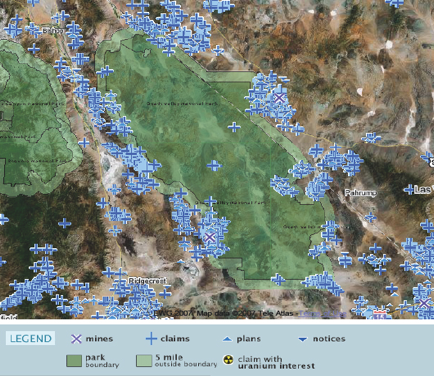
Source: Environmental Working Group analysis of Bureau of Land Management's LR2000 Database, July 2007 download.
Without proper safeguards for our public lands, protecting national parks from these claims can be very costly. In 1996, the federal government paid $65 million to buy out patented claims just three miles from Yellowstone National Park that would have been the site of a major gold mine. The mine would have been located at the headwaters of three streams that flow into the park.
National Parks and Monuments with mining claims within five miles include:
| Park or Monument | Active Claims | Claims Staked Since Jan. 2003 |
| Death Valley National Park, CA and NV | 1,693 | 503 |
| Arches National Park, UT | 869 | 864 |
| Grand Canyon National Park, AZ | 815 | 805 |
| Joshua Tree National Park, CA | 409 | 117 |
| Canyonlands National Park, UT | 233 | 233 |
| Mt. Saint Helens National Volcanic Monument, WA | 204 | 105 |
| Capitol Reef National Park, UT | 161 | 151 |
| Great Basin National Park, NV | 154 | 18 |
| Yosemite National Park, CA | 83 | 50 |
| Zion National Park, UT | 66 | 54 |
| Yellowstone National Park, ID, MT, WY | 21 | 1 |
The Legacy of Uranium Mining
Near the top left of the Utah/Colorado map on page six is the town of Moab, Utah. The Department of Energy has begun a project to clean up 16 million tons of radioactive uranium mine waste near Moab that have contaminated land near the Colorado River. The waste is a threat that could pollute drinking water for millions. Cleanup estimates range between $412 million and $697 million and, according to the Department of Energy, the project could last until 2028.
You’ll also note the town of Monticello, Utah at the far south of the map. Colorado’s Grand Junction Daily Sentinel recently reported that residents of Monticello claim unusually high rates of cancer they believe were caused by a now-closed uranium mill.
The Los Angeles Times reported in a landmark series last year how uranium mining has left a legacy of cancer and a degenerative disease known as Navajo Neuropathy on the Navajo reservation that includes Arizona, Colorado, Utah and New Mexico.
Uranium mining companies have said that a process called “in situ leaching” will reduce environmental harm, but the practice raises significant concerns about contamination of groundwater according to the U.S. Geological Survey (USGS) and Nuclear Regulatory Commission (NRC). In this type of mining, chemicals are injected underground to leach uranium out of subterranean deposits. While the USGS and NRC state that in situ leaching “in general” is less harmful than traditional uranium mining and milling, “the use of leaching fluids to mine uranium contaminates the groundwater aquifer in and around the region from which the uranium is extracted.” The agencies add that “groundwater restoration represents a substantial portion of the cost of decommissioning at a uranium leach mining facility.”
Mining is the Nation’s Leading Source of Toxic Pollution
But uranium mining is hardly the only cause for concern. According to the U.S. Environmental Protection Agency’s Toxics Release Inventory (TRI), metal mining as a whole is the leading source of toxic pollution in the United States – a distinction the industry has held for eight consecutive years (1998-2005), ever since mining was added to the TRI list.
The EPA has also reported that more than 40 percent of Western watersheds have mining contamination in their headwaters. The total cost of cleaning up metal mining sites throughout the West is an estimated $32 billion or more.
Unearthing Pollution
The extraordinary pollution generated by metal mining is caused largely by digging and the sheer size of contemporary mining operations. Modern mining practices are a far cry from the use of mules and pick axes that were common during the late 1800s when the Mining Law was written. In part, the techniques have changed because concentrated deposits of gold and other metals are largely gone. Mining companies now excavate "mineralized deposits," or ore that contains microscopic amounts of precious metal.
To extract the amount of ore they desire, modern mining operations typically have to remove enormous quantities of rock and dirt with heavy, earthmoving equipment. The holes they dig can exceed one mile in diameter and 1,000 feet in depth.
Mining companies commonly use cyanide or other chemicals to extract the metal. In this process, companies place the huge quantities of rock and earth on a plastic-lined heap leach pad and then spray or drip cyanide over the pile. As the cyanide trickles through the heap, it binds to the precious metal. The mining company then collects the metal from the cyanide solution in liquid-filled pits at the base of the rock pile.
Cyanide and other chemicals can poison water, land and wildlife near mines, but most mining pollution results from digging. When mining companies dig for metals, they expose sulfur-laden rock to air and water, resulting in the formation of sulfuric acid. The acid often drains away from the mine site into ground or surface water where it makes the water so acidic that fish and other organisms cannot survive. This phenomenon is known as acid mine drainage. At California's abandoned Iron Mountain mine, for instance, scientists discovered the world's most acidic water with a pH of -3.6, 10,000 times more acidic than battery acid.
The acid itself is not the only problem. When the acid comes in contact with rock, it dissolves toxic metals including arsenic, cadmium, lead and mercury, and carries those metals into water sources. Acid mine drainage from the Iron Mountain Mine, for example, has periodically released harmful levels of heavy metals into the Sacramento River and has virtually eliminated aquatic life in several nearby creeks. Roughly 70,000 people use surface water within three miles of Iron Mountain Mine as their source of drinking water. Acid mine drainage laden with heavy metals is a problem throughout the West from past and present mines.
Once it begins, such pollution is very difficult to stop. Roman metal mines are still draining acid in Europe. Closer to home, the EPA wrote that Newmont’s Phoenix proposal in Nevada “will likely create a perpetual and significant acid mine drainage problem requiring mitigation for hundreds of years.” Furthermore, reclaiming acid draining mines after mining ceases is a huge financial liability. The state of New Mexico estimates that one copper mine, the Chino Mine, will cost more than a quarter billion dollars to clean up.
Long-Distance Pollution
Mining pollution often spreads far beyond the site of the mine. For example, in Summitville, Colorado in 1992 a spill of cyanide and heavy metal-laden water killed some 20 miles of the Alamosa River. The area is now a Superfund Site. Taxpayers have already spent $190 million to clean up the area and will likely be tapped for millions more in the future.
Earlier this month, the EPA added Oregon’s Formosa mine to the Superfund list. The historic mine was reopened in the 1990s, mined for two years by a Canadian company and then abandoned with catastrophic results. The mine’s acid drainage has killed 18 miles of a creek where salmon once spawned and cleanup is expected to exceed $10 million, the Associated Press reported.
Another example of extended mining impacts is the plume of contaminated groundwater beneath the Bingham Canyon mine. The EPA reports that the plume extends for 72 square miles. The mine is part of the Kennecott South site about 25 miles southwest of Salt Lake City that has been proposed for Superfund status. The mining watchdog group, Earthworks, estimated that the Bingham Canyon mine will leave taxpayers with the largest liability of any mine in the United States: more than $1.3 billion.
A fourth example comes from Arizona in 2006, where dust from a 400-foot-high tailings pile at Phelps Dodge’s Sierrita Mine spread over a two- to four-and-a-half-mile radius, coating homes and lawns in nearby Green Valley with white powder. The company said it sampled the tailings several years earlier and found no cause for concern but the state cited the company for failing to prevent the dust from blowing onto homes.
Residents of Crested Butte, Colorado, Boise, Idaho and other towns, are currently facing significant mine proposals that could threaten local water supplies and other resources.
Antiquated Law
The threat we face today, however, is more serious than in years past. The specter of mining operations is looming over the Grand Canyon and many other treasured national parks, and the 1872 Mining Law provides inadequate tools to control it. Indeed, the 1872 Mining Law does the opposite: it directly facilitates the problem by granting mining rights with no government approval, providing weak standards for protecting water, and creating a potential bonanza with no royalty payments if the claim pans out. Under current law, demand for raw materials around the globe can place our public lands at risk and leave Westerners and federal land managers at the mercy of multinational mining companies.
Mining companies have argued against changing the law because mining is so important to our national security. Yet the oil and gas industry is also vital to our national security and has operated on federal land under a significantly different set of rules. Oil and gas operators must win government approval before gaining control of federal land, pay royalties on the energy they extract and are subject to rules that allow energy development to be balanced with other interests. Under this system, oil and gas companies have enjoyed record profits and record numbers of approvals for drilling permits in the past several years. Indeed, government oversight has often been far too lax. But the main point is that the oil and gas industry has thrived under a much more progressive legal framework.
Mining has operated under an antiquated law for long enough. When mining threatens to scar if not destroy places like the Grand Canyon, it is time to draw the line. We no longer need to give special treatment to the mining industry, particularly when other extractive industries operate profitably on our public lands without such favored treatment and particularly when our national parks and monuments are at risk.
Recommendations to Improve the Mining Law
We recommend several changes to the mining law:
- Protect Western lands: Mining companies should be allowed to operate on federal lands, but some places should be off-limits. These places include lands bordering National Parks, Forest Service Roadless Areas, and sacred sites.
- Tougher standards for mine permits and cleanup: Mining companies should be required to prevent perpetual water contamination and put up enough money before operations begin to cover the full costs of cleanup should the company go bankrupt or abandon the site.
- Treat Mining Like Oil and Gas: Land managers should have the ability to balance mining with other interests such as water quality, the same ability they have with oil and gas and other extractive industries.
- Royalty payments: Currently, mining companies pay no royalty unlike every other extractive industry operating on federal land. A fair return to taxpayers is essential for cleaning up abandoned mines and providing assistance for communities affected by the boom and bust mining economy.
- Abandoned mine cleanup fund: Cleaning up abandoned mines is estimated to cost $32 billion or more. Congress should create a fund to accomplish this important task.
- An end to mining’s tax break: In addition to being able to mine royalty-free, mining companies can claim a tax break on up to 22 percent of the income that they make off hardrock minerals mined on federal public lands. Congress should close this loophole.
- No more land giveaways: For years, mining interests have been able to buy claimed land from the federal government for $2.50 or $5.00 an acre. Since 1994, Congress has placed a moratorium on these giveaways that must be renewed annually. Congress should enact a permanent ban.
Mining provides materials essential to our economy, but it must be conducted in a way that strikes a balance with other values. We look forward to working with the Committee to ensure that mining on our public lands is conducted in a responsible manner.
Thank you for this opportunity to testify.
###


